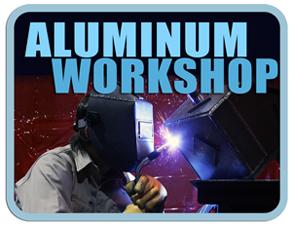President
- FMA
- The Fabricator
- FABTECH
- Canadian Metalworking
Categories
- Additive Manufacturing
- Aluminum Welding
- Arc Welding
- Assembly and Joining
- Automation and Robotics
- Bending and Forming
- Consumables
- Cutting and Weld Prep
- Electric Vehicles
- En Español
- Finishing
- Hydroforming
- Laser Cutting
- Laser Welding
- Machining
- Manufacturing Software
- Materials Handling
- Metals/Materials
- Oxyfuel Cutting
- Plasma Cutting
- Power Tools
- Punching and Other Holemaking
- Roll Forming
- Safety
- Sawing
- Shearing
- Shop Management
- Testing and Measuring
- Tube and Pipe Fabrication
- Tube and Pipe Production
- Waterjet Cutting
Industry Directory
Webcasts
Podcasts
FAB 40
Advertise
Subscribe
Account Login
Search
Aluminum Workshop: Tensile Testing Welding for 6061-T6
- By Frank Armao
- Updated August 8, 2023
- December 26, 2014
- Article
- Aluminum Welding
Q: I am having problems passing the tensile tests for my procedure qualification of aluminum alloy 6061-T6 on 6-inch-diameter pipe, Schedule 120.
I am using ER4043 filler metal for a gas tungsten arc welding (GTAW)-gas metal arc welding (GMAW) combination process on the first joint and ER5363 on the second joint. None of the joints passed both the wraparound side bend tests and reduced section tension tests. All test specimens broke in the weld area with and without some porous indication in the GMA weld deposits.
For tension tests I got only 50 percent of the required minimum yield strength.
What went wrong with my welding procedures?
A: Good question. I can’t give you a definite answer without a little more information. It would help to know if the tensile samples failed in the weld, at the fusion line, or in the heat-affected zone (HAZ). It also would help to know in detail how the bend samples failed.
Having said that, let me give you some possibilities. The tensile samples should fail in the HAZ. If they do, but they fail at a low strength value, I would bet that the problem is that you preheated the weld excessively. Preheat should be avoided on heat-treatable alloys. If it’s used at all, ,it must be limited to a maximum of 200 degrees F. Excessive preheat or excessive weld heat input can destroy the mechanical properties of 6061-T6 with the results you described.
If the tensile samples failed in the weld, I believe you have a weld quality problem. However, the porosity you see didn’t cause the failure. Porosity in aluminum welds, while common, is a relatively benign defect. It’s only real effect is that it reduces yield and tensile strengths by a percentage e3equal to the volume fraction of porosity. A really bad weld contains around 5 percent porosity by volume, so the yield and tensile strengths are reduced by 5 percent. I’ve never seen a reduction in strength more than this that was caused by weld porosity.
If the tensile samples fail throughout the weld, lack of fusion in the weld is the most likely cause. This should show up as a flat gray area on the fracture face of the tensile sample and should be fairly easy to see.>/p>
Any lack of fusion in the weld also will cause bend samples to fail after only a small amount of bending. However, many bend test failures also are caused by improper bend test procedures. Aluminum bend samples are machined and tested differently than steel bend test samples. You should test 6061-T6 samples at 1/8-inch thickness, not the common 3/8-in. thickness used for other materials.
Additionally, wraparound-type bend testing equipment is recommended for bend testing aluminum samples, rather than the plunger-type equipment commonly used to test steel bend samples. Schematic drawings of both types of equipment can be found in the American Welding Society’s D1.2 Structural Welding Code—Aluminum.
For more information on bend testing, read "Preparing, testing bend samples," which appeared in this column in the September/October 2002 issue.
About the Author

Frank Armao
Aluminum Consulting Inc.
440-479-0239
About the Publication
Related Companies
subscribe now

The Welder, formerly known as Practical Welding Today, is a showcase of the real people who make the products we use and work with every day. This magazine has served the welding community in North America well for more than 20 years.
start your free subscription- Stay connected from anywhere

Easily access valuable industry resources now with full access to the digital edition of The Fabricator.

Easily access valuable industry resources now with full access to the digital edition of The Welder.

Easily access valuable industry resources now with full access to the digital edition of The Tube and Pipe Journal.
- Podcasting
- Podcast:
- The Fabricator Podcast
- Published:
- 04/16/2024
- Running Time:
- 63:29
In this episode of The Fabricator Podcast, Caleb Chamberlain, co-founder and CEO of OSH Cut, discusses his company’s...
- Trending Articles
Sheffield Forgemasters makes global leap in welding technology

Welding student from Utah to represent the U.S. at WorldSkills 2024

Lincoln Electric announces executive appointments

Lincoln Electric acquires RedViking

Engine-driven welding machines include integrated air compressors

- Industry Events
16th Annual Safety Conference
- April 30 - May 1, 2024
- Elgin,
Pipe and Tube Conference
- May 21 - 22, 2024
- Omaha, NE
World-Class Roll Forming Workshop
- June 5 - 6, 2024
- Louisville, KY
Advanced Laser Application Workshop
- June 25 - 27, 2024
- Novi, MI



























